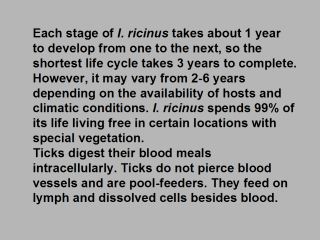 |
The
acquisition and transmission of pathogens are separated by long periods of
free living. A series of hormonally mediated changes occur in the body of
the feeding tick during the first day of host contact; The tick is blind,
but senses carbon dioxide, temperature, odors, ammonia and movements. The
Hallerís organ on the final segment of the first pair of legs, serves for
orientation during feeding. Questing ?
The tick is waiting on vegetation for a host. Flagging ? A flag of
say 1 square m of cloth on a stick is dragged. Ticks jump on the flag from
which they can be collected. Traps can have dry ice as an attractant.
|
